 |
Recent scientific studies confirm the poets' claim - love really does make the mind work differently.  Legendary pianist Arthur Rubinstein (1887 - 1983) loved life to the fullest. He once described himself as the happiest person he had ever met. His music is a unique reflection of that outlook. Yet, his attitude also raised suspicions of shallowness. Legendary pianist Arthur Rubinstein (1887 - 1983) loved life to the fullest. He once described himself as the happiest person he had ever met. His music is a unique reflection of that outlook. Yet, his attitude also raised suspicions of shallowness.
We expect great artists to suffer. Yet, as Harold Schonberg noted in The Glorious Ones, Rubinstein was one of the very few musicians who died contented, having lived a fabulous and rewarding life and having achieved all he had wanted professionally. Schonberg muses that Rubinstein's only regrets were the cigars he hadn't yet smoked and the wines he hadn't yet tasted (to which perhaps should be added the women he hadn't yet loved).
His die was cast early. A musical prodigy in the dreary Polish industrial city of Lodz, Rubinstein became a protégé of Joseph Joachim, the most famous teacher of his time. Joachim introduced him to the luminaries of Berlin concert and social life yet insisted that the boy's talent not be prematurely exploited. But the combination of temptation and containment proved explosive - soon after his long-delayed public debut in 1900, Rubinstein's voracious romantic appetite surfaced and he set out to prove, consistent with his recent Bar Mitzvah, that indeed he had “become a man.” His first conquest was his landlord's wife, soon followed by a friend's mother and sister (both married). There was also an intriguing arrangement by which he serviced girls attracted to his gay friends.
Rubinstein's teen years raise the question that would haunt his reputation throughout his life - if only he had more discipline and focused more on his art, could he have developed into a deeper interpreter? Seizing upon Rubinstein's life-long devotion to philandering and high living, detractors repeatedly (and perhaps jealously?) faulted him for laziness, technical lapses, narrow repertoire and simplification of difficult musical passages (all of which were true).
Yet, Rubinstein's amorous ventures were not mere distractions. Rather, they formed an integral part of his personality and led him to integrate the full fabric of life into his music. Rubinstein himself insisted that far more important than extensive practice was “learning about life and love and art and all the other wonderful things in the world” in order to have something worth expressing. While critics seized upon what might have been, the public adored him, perhaps intuitively responding to the fullness of his heart. 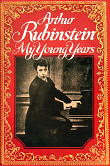 Rubinstein's art was not superficial but reflected the joy and contentment of the total experience of living.
Rubinstein's art was not superficial but reflected the joy and contentment of the total experience of living.
It's only fair to note that Rubinstein didn't transmute his attitude into an exemplary life. He abandoned his parents and siblings, ignored his children, deceived his wife and was an irrepressible spendthrift who constantly lived far beyond his means, shamelessly mooching off anyone with money and wasting his energies on giving private concerts to wealthy patrons.
Rubinstein's memoirs (My Young Years and My Many Years) are generally dismissed as a superficial and disappointing catalog of lovers and society friends, with barely a word about musical taste, piano technique or artistic vision. Yet, these two volumes are a perfect barometer of Rubinstein's outlook - they reflect the aspects of life that mattered the most to him and which flavored his feelings and his art. The rest can be gleaned from his records.
Rubinstein made a lot of records - over 100 hours' worth.  Even two decades after his death, they remain hugely popular. Yet, in one of the most boneheaded acts in the annals of classical marketing, BMG reissued them all in a single $1500 box (really more of a crate). Our local Tower has had one on display, weighing in at around 40 pounds (including all the dust it's collected since its arrival). Who exactly was expected to buy this monstrosity? Surely any devoted fan already would have bought previous CD issues of nearly all the contents. And would a newcomer really want all the multiple remakes to which the bulk of the set is devoted (ie: four versions each of the Grieg, Schumann, Beethoven Emperor and Chopin Second concertos)? Even two decades after his death, they remain hugely popular. Yet, in one of the most boneheaded acts in the annals of classical marketing, BMG reissued them all in a single $1500 box (really more of a crate). Our local Tower has had one on display, weighing in at around 40 pounds (including all the dust it's collected since its arrival). Who exactly was expected to buy this monstrosity? Surely any devoted fan already would have bought previous CD issues of nearly all the contents. And would a newcomer really want all the multiple remakes to which the bulk of the set is devoted (ie: four versions each of the Grieg, Schumann, Beethoven Emperor and Chopin Second concertos)?
Reportedly only a few hundred sets were sold worldwide. Whether to appease collectors or, more likely, to recoup losses from a commercial disaster, BMG finally issued individual volumes, each in a CD-sized hard-back paper booklet. While the format is a viable alternative to the standard jewelbox, the design is a bit perverse, with titles on the spines so dim to demand x-ray vision to glean the contents and discs tucked in so tightly to require supernatural powers to extract them without scratches and fingerprints.
Here are the releases which strike me as the most significant. Let's start with Rubinstein's famed Chopin (including a stunning live Moscow recital); and then proceed with his early records; then solos of Brahms, Schumann, Schubert, Beethoven and Liszt; Spanish and French music; chamber music; concertos; and his final recordings. Where multiple versions of a work exist I've generally selected only one, although most alternates should be fine, too.
Chopin
So much has already been written by others in praise of Rubinstein as the foremost exponent of Chopin that I couldn't hope to add any significant new insight. 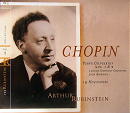 (To capitalize on this reputation, BMG has pegged all of the Chopin in its Rubinstein Collection at full price, rather than the mid-price level of all the other volumes.) The accepted wisdom is: (a) the 19th Century viewed Chopin as an effete, sickly neurotic, (b) 20th Century performers felt obliged to compensate with self-indulgent, ego-driven mannerism and (c) Rubinstein rescued his compatriot from such decadence with a self-effacing, natural sincerity that restored Chopin's powerful nobility and exalted the inherent beauty and subtle rhythm of his music. The only flaw with this view is the evidence of Rubinstein's first two Chopin records (on volume 2, made when he was already middle-aged and well-established), which rank among the most highly-individualized Chopin performances of all. Yet, perhaps the ultimate validation for this approach lies in the proclamations of authenticity by Poles, in whose traditions both Chopin and Rubinstein were rooted. (To capitalize on this reputation, BMG has pegged all of the Chopin in its Rubinstein Collection at full price, rather than the mid-price level of all the other volumes.) The accepted wisdom is: (a) the 19th Century viewed Chopin as an effete, sickly neurotic, (b) 20th Century performers felt obliged to compensate with self-indulgent, ego-driven mannerism and (c) Rubinstein rescued his compatriot from such decadence with a self-effacing, natural sincerity that restored Chopin's powerful nobility and exalted the inherent beauty and subtle rhythm of his music. The only flaw with this view is the evidence of Rubinstein's first two Chopin records (on volume 2, made when he was already middle-aged and well-established), which rank among the most highly-individualized Chopin performances of all. Yet, perhaps the ultimate validation for this approach lies in the proclamations of authenticity by Poles, in whose traditions both Chopin and Rubinstein were rooted.
Rubinstein recorded (and rerecorded) more Chopin than any other composer (by far!) and the choices are bewildering. There were three principal series - sets of the polonaises, nocturnes, concerti, mazurkas and scherzos for EMI in the 1930s (volumes 4 - 6), mono LPs for RCA of these same pieces plus the preludes and waltzes (volumes 17 and 26 - 29) and final RCA stereo remakes of all but the preludes plus the sonatas and ballades (on volumes 44 - 50). The EMIs tend to have greater velocity and energy, while the stereo sets are highly burnished and deeply relaxed; the mono RCAs fall somewhat in between (and for that very reason tend to be the most interesting).
But there's a problem - all of these albums are complete sets of genre pieces that were neither composed nor meant to be heard all together. Aside from the Preludes and Etudes (which were published together) and the Waltzes (which display a wide variety of mood) two solid hours of nocturnes or mazurkas is way too much for a single sitting! For that reason alone, my first choice among Rubinstein studio Chopin collections goes outside the BMG Edition for the first Rubinstein volume in the Great Pianists of the 20th Century series (Philips 456 955-2), which provides a mid-priced 2 1/2 hour survey of the Sonata # 2 and a nicely-balanced selection of nocturnes, waltzes, polonaises, impromptus, scherzos, ballades, etudes and mazurkas (all derived from the final stereo sets). Unfortunately, it's the only Rubinstein album that assembles a variety of Chopin pieces into a sensible program. Yet there's one further choice that trumps them all:
Live Concerts
- Recital in Moscow - Chopin: Piano Sonata # 2; Polonaises, Opp. 44 and 53; Etudes, Op. 10 #s 4 and 5, Op. 25 #s 1 and 5; Impromptu, Op. 51; Nocturne, Op. 27 # 2; Barcarolle; Waltzes, Op. 34, #s 1 and 2; Schumann: Des Abends; Debussy: Ondine; Villa-Lobos: O Polichinelo (October 1, 1964). Volume 62 (2 CDs).
Rubinstein thrived on audiences, both private and public. Unfortunately, only three of the 81 volumes of the Rubinstein Collection present him in concert.  What an incredible difference! His studio records are wonderful, but rather deliberate, measured and tempered. Here, though, is the artist who floored audiences in a fabulous program of Chopin and a few encores. Every accent bursts with expression - bold, passionate, committed and driven with huge dynamics and stunning rhythmic control. The second waltz is so utterly awesome that the otherwise choleric audience barely breathes, and the spell-breaking applause at the end seems a sacrilege. The excitement is abetted by the crystalline sharpness of the recording, which reveals details of color that the mellowness of the studio records sometimes blurs. While it's rather chintzy for BMG to charge double for a mere 88 minutes of music, this set still is a great value for its supreme quality that easily outweighs its slender quantity. If you can only get one volume of the Rubinstein Collection, or want only a single example of his Chopin, let it be this. What an incredible difference! His studio records are wonderful, but rather deliberate, measured and tempered. Here, though, is the artist who floored audiences in a fabulous program of Chopin and a few encores. Every accent bursts with expression - bold, passionate, committed and driven with huge dynamics and stunning rhythmic control. The second waltz is so utterly awesome that the otherwise choleric audience barely breathes, and the spell-breaking applause at the end seems a sacrilege. The excitement is abetted by the crystalline sharpness of the recording, which reveals details of color that the mellowness of the studio records sometimes blurs. While it's rather chintzy for BMG to charge double for a mere 88 minutes of music, this set still is a great value for its supreme quality that easily outweighs its slender quantity. If you can only get one volume of the Rubinstein Collection, or want only a single example of his Chopin, let it be this.
- Carnegie Hall Highlights - Debussy: La cathédrale engloutie, Poissons d'or, Hommage à Rameau, Ondine; Szymanowski: Mazurkas, Op. 50;
Prokofiev: 12 Visions fugitives, Op. 22; Villa-Lobos: Prole do bebê; Schumann: Arabeske; Albinez: Navarra (Carnegie Hall, October - December 1961). Volume 42.
This is the second of Rubinstein's three live albums. (Click here for the third.) Together with the Schumann Symphonic Études on volume 39, this disc collects all the material that Rubinstein approved for release from the marathon of ten concerts, all with entirely different programs, that he gave in New York for charity in late 1961. The repertoire included Beethoven, Brahms, Liszt, Schubert and Chopin sonatas, major Schumann works and above all the Petroushka suite that Stravinsky arranged expressly for him but which he never recorded. While these encores are all fine, what a shame that out of apparent deference to Rubinstein's wishes the producers continue to suppress the rest, all of which were taped and which would have immeasurably increased our knowledge of the artist. The little we have includes Rubinstein's only recording of the Prokofiev (which he presents with unaccustomed warmth), and the other scraps are all more vividly etched than their studio counterparts. But even if there were flaws of some sort in the missing 90 percent of these concerts, it sure would have been nice ... that Rubinstein approved for release from the marathon of ten concerts, all with entirely different programs, that he gave in New York for charity in late 1961. The repertoire included Beethoven, Brahms, Liszt, Schubert and Chopin sonatas, major Schumann works and above all the Petroushka suite that Stravinsky arranged expressly for him but which he never recorded. While these encores are all fine, what a shame that out of apparent deference to Rubinstein's wishes the producers continue to suppress the rest, all of which were taped and which would have immeasurably increased our knowledge of the artist. The little we have includes Rubinstein's only recording of the Prokofiev (which he presents with unaccustomed warmth), and the other scraps are all more vividly etched than their studio counterparts. But even if there were flaws of some sort in the missing 90 percent of these concerts, it sure would have been nice ...
Early Recordings
- Chopin: 2 Waltzes, 3 Mazurkas; Liszt: Consolation # 3, Hungarian Rhapsody # 10, Liebestraum # 3; Rachmaninoff: Prelude, Op. 3 # 2; Debussy: La cathedrale engloutie, Prelude; Ravel: Forlane; Granados: The Maiden and the Nightingale; Falla: Dance of Terror, Ritual Fire Dance; Villa-Lobos: Moreninha, A pobrezinha, O Polichinelo. (1928 - 1937) Volume 2.
Rubinstein often proclaimed that the summer of 1934 was the turning point in his professional life. Aged 47, recently married and with a baby daughter,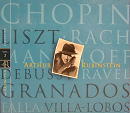 Rubinstein claimed to have confronted himself and resolved to practice intensively and to focus his energies on technical excellence that up to that point he had finessed so that his legacy wouldn't be one of having squandered the full scope of his talent. The selections here range from 1928 to 1937 and document the extraordinary level Rubinstein achieved after his self-confrontation, emerging with a more secure technique, firmer rhythm and greater nuance than before - the precision of the scales in the 1937 Liszt Hungarian Rhapsody # 10 is simply amazing. Yet, those which precede The Summer are extraordinary as well, bristling with a freshness, freedom and impulse that his mellow, probative poetic remakes wouldn't recapture. Most startling of all are two jagged and edgy Chopin Waltzes which send off constant sparks of genuine excitement and incomparable tension. Due to the popularity of his suave stereo recordings and the persistence of the mythic figure he would later became, we tend to forget the energy and sparkle of the earlier artist. Admittedly, even the first of these aren't youthful recordings - aside from two sides allegedly cut in Poland in 1910 (which appear to be lost) and some piano rolls, Rubinstein didn't begin to record until he was already 40 - but perhaps they help us infer the young man who boldly attacked the pernicious myth of Chopin as a bland, sentimental weakling. Rubinstein claimed to have confronted himself and resolved to practice intensively and to focus his energies on technical excellence that up to that point he had finessed so that his legacy wouldn't be one of having squandered the full scope of his talent. The selections here range from 1928 to 1937 and document the extraordinary level Rubinstein achieved after his self-confrontation, emerging with a more secure technique, firmer rhythm and greater nuance than before - the precision of the scales in the 1937 Liszt Hungarian Rhapsody # 10 is simply amazing. Yet, those which precede The Summer are extraordinary as well, bristling with a freshness, freedom and impulse that his mellow, probative poetic remakes wouldn't recapture. Most startling of all are two jagged and edgy Chopin Waltzes which send off constant sparks of genuine excitement and incomparable tension. Due to the popularity of his suave stereo recordings and the persistence of the mythic figure he would later became, we tend to forget the energy and sparkle of the earlier artist. Admittedly, even the first of these aren't youthful recordings - aside from two sides allegedly cut in Poland in 1910 (which appear to be lost) and some piano rolls, Rubinstein didn't begin to record until he was already 40 - but perhaps they help us infer the young man who boldly attacked the pernicious myth of Chopin as a bland, sentimental weakling.
- Brahms: Concerto # 2 (London Symphony Orchestra, Albert Coates, 1928); Tchaikovsky: Concerto # 1 (London Symphony Orchestra, John Barbirolli, 1932). Volume 1.
The Brahms was Rubinstein's first orchestral recording. He would later complain about the rushed circumstances (he met the conductor and orchestra for the first time at the session),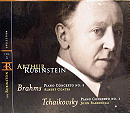 and indeed the jarring discontinuous leaps between sections suggest hasty preparation. Yet, Rubinstein plays expressively and Coates leads boldly (although not quite with the visceral excitement he brought to his famous 1930 Rachmaninoff Third with Horowitz). It's giddy and fleet - indeed, it's by far the fastest account ever committed to record (39:58, compared with runner-up Toscanini/Horowitz's 44:07), especially the roiling central section of the andante that all modern accounts invest with considerable weightiness. But before writing it off as willful and capricious (or rushed to fit onto 78 sides), consider this: it's still not as fast as Brahms had specified. So, rather than being an anomaly it turns out that this is as close to an authentic interpretation as any we have! In the Tchaikovsky, Rubinstein and one of his favorite conductors bask in empathy and project a unified vision that's exciting without becoming fiery. The transfers are surpisingly noisy and the sound is thin, but with a bite and snarl that adds to the excitement and impact. and indeed the jarring discontinuous leaps between sections suggest hasty preparation. Yet, Rubinstein plays expressively and Coates leads boldly (although not quite with the visceral excitement he brought to his famous 1930 Rachmaninoff Third with Horowitz). It's giddy and fleet - indeed, it's by far the fastest account ever committed to record (39:58, compared with runner-up Toscanini/Horowitz's 44:07), especially the roiling central section of the andante that all modern accounts invest with considerable weightiness. But before writing it off as willful and capricious (or rushed to fit onto 78 sides), consider this: it's still not as fast as Brahms had specified. So, rather than being an anomaly it turns out that this is as close to an authentic interpretation as any we have! In the Tchaikovsky, Rubinstein and one of his favorite conductors bask in empathy and project a unified vision that's exciting without becoming fiery. The transfers are surpisingly noisy and the sound is thin, but with a bite and snarl that adds to the excitement and impact.
- Brahms: Piano Quartet # 1, Op. 25 (1932, with members of the Pro Arte Quartet); Sonata for Violin and Piano # 3, Op. 108 (1932, with Paul Kochanski, violin); Sonata for Cello and Piano # 1, Op. 38 (1936, with Gregor Piatigorsky, cello). Volume 3.
As the liner notes point out, Rubinstein consistently turned to Brahms for "firsts" in his recording career - his first solo record was a Brahms Capriccio (on volume 8),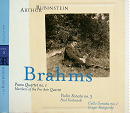 his first concerto recording was the Brahms First (on volume 1) and his first chamber recordings are the ones collected here. Despite their longevity and fame, the Pro Arte Quartet is faulted nowadays for their loose ensemble, which is no longer in vogue. But the criticism is really a credit to the aura of relaxed friendliness that can be quite disarming and fits right in with Rubinstein's own artistic (and personal) temperament. On the other hand, when they do explode, as they frequently do in the finale of the Quartet # 1, the contrast is a real ear-opener. Although the opening is perhaps a bit too easy-going, the andante con moto is meltingly lovely and the frequent tempo transitions are as natural as breathing. It's hardly a surprise that these very same qualities imbue the Violin Sonata - Rubinstein met Kochanski when they were both 14 and formed an immediate and permanent personal and artistic bond. It's clear from this record that they were musical soul-mates. Sadly, although they often performed together, this was to be their only recording, as Kochanski died soon after, leaving Rubinstein to outlive him by half a century. his first concerto recording was the Brahms First (on volume 1) and his first chamber recordings are the ones collected here. Despite their longevity and fame, the Pro Arte Quartet is faulted nowadays for their loose ensemble, which is no longer in vogue. But the criticism is really a credit to the aura of relaxed friendliness that can be quite disarming and fits right in with Rubinstein's own artistic (and personal) temperament. On the other hand, when they do explode, as they frequently do in the finale of the Quartet # 1, the contrast is a real ear-opener. Although the opening is perhaps a bit too easy-going, the andante con moto is meltingly lovely and the frequent tempo transitions are as natural as breathing. It's hardly a surprise that these very same qualities imbue the Violin Sonata - Rubinstein met Kochanski when they were both 14 and formed an immediate and permanent personal and artistic bond. It's clear from this record that they were musical soul-mates. Sadly, although they often performed together, this was to be their only recording, as Kochanski died soon after, leaving Rubinstein to outlive him by half a century.
Rubinstein rerecorded all three of these works in stereo - the Quartet with the Guarneri in 1967 (on volume 65); the Violin Sonata with Henryk Szeryng in 1960 (on volume 41); and the Cello Sonata again with Piatigorsky in 1966 (on volume 64). Filling out these volumes are Rubinstein's only recorded performances, respectively, of the Quartet # 3, the Violin Sonatas #s 2 and 3 and the Cello Sonata # 2. As is to be expected, the remakes lack the edgy excitement of the earlier versions but substitute a greater repose, smoother flow and richer blend, and magnificently convey a mature view of the Brahmsian style. Thus, the cantabile sections are achingly lovely, accents are strong, and the overall concept remains fundamentally assertive, all within a tight sense of control.
- Bach: Toccata: Prelude, Adagio & Fugue (arranged by Busoni) (1934); Schubert: Impromptu, Op 90 # 4 (1928); “Minuetto” from Piano Sonata, Op. 78, K. 894 (1936); Schumann: Romance, Op. 28, # 2 (1937), Arabeske, Traumerei and Widmung (1947); Brahms: Capriccio, Op. 76 # 2 (1928), Rhapsody, Op. 79 # 2 (1937); Wiegenlied (1947); Anton Rubinstein: Valse-Caprice (1935). Volume 8.
This short (56 minute) collection of Rubinstein concert favorites opens and concludes with pieces of particular interest. Rubinstein claimed to revere Bach above all keyboard composers,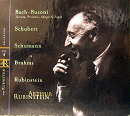 yet he played only Romanticized arrangements (as, in fairness, did every other artist of his generation, even self-proclaimed purists like Toscanini). Of the only two he recorded, both in virtuoso adaptations by Busoni, the Toccata is rich, noble and (perhaps by minimizing interpretive rhetoric) closer in spirit to the original than in many other less-tamed hands (although Rubinstein's adagio section is still quite lush). His ardent performance of the Valse-Caprice transcends any ambivalence he may have harbored toward his older namesake Anton Rubinstein, with whom he was constantly confused and frustrated in launching his own career. Although he wasn't deeply devout, Arthur Rubinstein was fiercely proud of being Jewish and one of his early triumphs was winning the audience (but not the prize) at the 1910 Anton Rubinstein competition, which he attended, in part, to defy the St. Petersburg law that barred Jews from being in that city for more than 24 hours. Beyond favorite Brahms and Schumann items, this disc also includes a single movement from the Schubert Sonata, Op. 78, in which Rubinstein sensibly integrates the recurring powerful opening figure and the reflective episodes that follow; aside from this fragment and the two pieces on volume 54 he didn't explore any of Schubert's longer works. yet he played only Romanticized arrangements (as, in fairness, did every other artist of his generation, even self-proclaimed purists like Toscanini). Of the only two he recorded, both in virtuoso adaptations by Busoni, the Toccata is rich, noble and (perhaps by minimizing interpretive rhetoric) closer in spirit to the original than in many other less-tamed hands (although Rubinstein's adagio section is still quite lush). His ardent performance of the Valse-Caprice transcends any ambivalence he may have harbored toward his older namesake Anton Rubinstein, with whom he was constantly confused and frustrated in launching his own career. Although he wasn't deeply devout, Arthur Rubinstein was fiercely proud of being Jewish and one of his early triumphs was winning the audience (but not the prize) at the 1910 Anton Rubinstein competition, which he attended, in part, to defy the St. Petersburg law that barred Jews from being in that city for more than 24 hours. Beyond favorite Brahms and Schumann items, this disc also includes a single movement from the Schubert Sonata, Op. 78, in which Rubinstein sensibly integrates the recurring powerful opening figure and the reflective episodes that follow; aside from this fragment and the two pieces on volume 54 he didn't explore any of Schubert's longer works.
Solo Recordings
- Brahms: Sonata # 3, Op. 5, Intermezzo, Op. 116 # 6; Romance, Op. 118 # 5 (all 1959); Ballades, Op. 10 (1970). Volume 63.
While the rest of the world thought of him as a Chopin expert, Rubinstein himself claimed Brahms to be his favorite composer. His exposure to the composer, although indirect,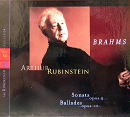 came early through his childhood mentor Joachim, who was a close personal friend of Brahms and the dedicatee of his Violin Concerto and “Double” Concerto for violin and cello (and played the world premiere of both works under the composer's baton). The Sonata and Ballades are both youthful works, and it's thrilling to hear a youthful pianist like Julius Katchen launch into them boldly. Rubinstein, though, plays them comfortably alongside later Brahms, enobling them with splendor and richness. came early through his childhood mentor Joachim, who was a close personal friend of Brahms and the dedicatee of his Violin Concerto and “Double” Concerto for violin and cello (and played the world premiere of both works under the composer's baton). The Sonata and Ballades are both youthful works, and it's thrilling to hear a youthful pianist like Julius Katchen launch into them boldly. Rubinstein, though, plays them comfortably alongside later Brahms, enobling them with splendor and richness.
- Schubert: Piano Sonata in B-flat, D. 960, Fantasie, D. 760 ("Wanderer") (both 1963), Impromptus, Op. 90, #s 3 and 4 (1961). Volume 54.
Most of the great Romantic piano composers were temperamental, repressed or just plain eccentric. Schubert, though, reportedly was the type of open, fun party guy with whom Rubinstein could identify,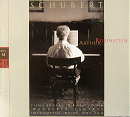 and so it's no surprise that a deep affinity imbues his few Schubert records. Although Rubinstein later proclaimed his love of Schubert, the composer was widely ignored throughout the era when Rubinstein's taste was formed, and so it's no surprise that he played only one of the Schubert sonatas, and then only in the 1960s, although he recorded it three times in that decade. While critics generally panned the final version of which he approved release, this middle one was issued posthumously and is wonderful; as with early Brahms, Rubinstein tempers the youthful ardor with a mature probity that might have amazed the composer himself. From the same session came an equally lustrous account of the “Wanderer” Fantasy, which Rubinstein had played since the turn of the century. With the subtle diffidence he brought to the delicate filigree of the last two Impromptus, it's a shame he never recorded any of the others. Indeed, given his wonderful way with these pieces, it's an even greater pity that he never involved himself with Schubert's other large-scale works. and so it's no surprise that a deep affinity imbues his few Schubert records. Although Rubinstein later proclaimed his love of Schubert, the composer was widely ignored throughout the era when Rubinstein's taste was formed, and so it's no surprise that he played only one of the Schubert sonatas, and then only in the 1960s, although he recorded it three times in that decade. While critics generally panned the final version of which he approved release, this middle one was issued posthumously and is wonderful; as with early Brahms, Rubinstein tempers the youthful ardor with a mature probity that might have amazed the composer himself. From the same session came an equally lustrous account of the “Wanderer” Fantasy, which Rubinstein had played since the turn of the century. With the subtle diffidence he brought to the delicate filigree of the last two Impromptus, it's a shame he never recorded any of the others. Indeed, given his wonderful way with these pieces, it's an even greater pity that he never involved himself with Schubert's other large-scale works.
- Schumann: Kreisleriana,Op. 16 (1964); Fantasia, Op. 17 (1965). Volume 52.
- Schumann: Carnival, Op. 9; Fantasiestuck, Op. 12 (1962). Volume 51.
- Schumann: Études symphoniques, Op. 13 (1961, live at Carnegie Hall); Piano Concerto (RCA Symphony Orchestra, Joseph Krips conducting, 1958). Volume 39.
As with Brahms, Rubinstein was immersed in Schumann from the outset of his serious studies, first through Joachim, who had known the composer, and then through other musicians who had studied with the composer's wife Clara. 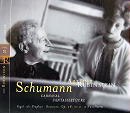 Perhaps his own pursuit of romance led Rubinstein to feel a special spiritual kinship with Schumann, the most ardently romantic of all the Romantic composers. Just listen to the opening phrase of the Fantasia - in Rubinstein's hands its yearning tears your heart out, a shattering depiction of the composer's own suffering over his love for Clara, whose father cruelly kept them apart. Yet, Rubinstein constantly tempers the various moods with reflection and melancholy, accurately depicting the composer's delicate and modest personality more accurately than, say, the coy playfulness of Kempff or the bold volatility of Cortot. The mellow vantage Rubinstein brought to his Schumann wasn't merely a function of his advancing age; comparison with the records left by Clara's pupil Fanny Davies (on Pearl CD 9291) reveals a strikingly similar understated approach that must be deemed authentic, as Clara devoted her long teaching career after Robert's death to perpetuating the way he had played his own works and demanding that her students follow suit. The 1958 recording of the Piano Concerto boasts a lovely, lean chamber-textured accompaniment with prominent winds; Rubinstein sounds a bit perfunctory and detached, though, and his rerecording it with Giulini and the Chicago Symphony barely nine years later suggests that he wasn't entirely pleased with the result. Perhaps his own pursuit of romance led Rubinstein to feel a special spiritual kinship with Schumann, the most ardently romantic of all the Romantic composers. Just listen to the opening phrase of the Fantasia - in Rubinstein's hands its yearning tears your heart out, a shattering depiction of the composer's own suffering over his love for Clara, whose father cruelly kept them apart. Yet, Rubinstein constantly tempers the various moods with reflection and melancholy, accurately depicting the composer's delicate and modest personality more accurately than, say, the coy playfulness of Kempff or the bold volatility of Cortot. The mellow vantage Rubinstein brought to his Schumann wasn't merely a function of his advancing age; comparison with the records left by Clara's pupil Fanny Davies (on Pearl CD 9291) reveals a strikingly similar understated approach that must be deemed authentic, as Clara devoted her long teaching career after Robert's death to perpetuating the way he had played his own works and demanding that her students follow suit. The 1958 recording of the Piano Concerto boasts a lovely, lean chamber-textured accompaniment with prominent winds; Rubinstein sounds a bit perfunctory and detached, though, and his rerecording it with Giulini and the Chicago Symphony barely nine years later suggests that he wasn't entirely pleased with the result.
- Beethoven: Piano Sonatas #s 8 (“Pathetique”), 14 ("“Moonlight”), 23 (“Appassionata”) and 26 (“Les Adieux”) (1962). Volume 56.
Rubinstein's superb performances of these “name ”sonatas give full expression to the depth of Beethoven's feelings but always within a context of intrinsic musicality. 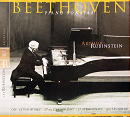 Rubinstein's rich playing imbues the whole program with a deep burnished glow, but perhaps the greatest reward lies in the way he transmutes the raw power of the most overtly disquieting movements - the plangent drama of the opening of the “Pathetique,” the disquieting brooding of the “Appassionata” and especially the enraged finale of the “Moonlight.” Without losing any of the sheer elemental fury, he enriches the mood by giving equal rein to elements of grace and human empathy and thereby universalizes the experience. It's not that music this enduring is in any real danger of being overlooked, but Rubinstein manages to preserve the original conception while adding his own humanistic contribution to enhance the experience even further. Rubinstein's rich playing imbues the whole program with a deep burnished glow, but perhaps the greatest reward lies in the way he transmutes the raw power of the most overtly disquieting movements - the plangent drama of the opening of the “Pathetique,” the disquieting brooding of the “Appassionata” and especially the enraged finale of the “Moonlight.” Without losing any of the sheer elemental fury, he enriches the mood by giving equal rein to elements of grace and human empathy and thereby universalizes the experience. It's not that music this enduring is in any real danger of being overlooked, but Rubinstein manages to preserve the original conception while adding his own humanistic contribution to enhance the experience even further.
- Liszt: Funérailles, Valse-Impromptu, Valse oubliée # 1, Mephisto Waltz # 1, Liebestraum # 3, Hungarian Rhapsodies #s 10 and 12, Consolation # 3; Anton Rubinstein: Barcarolles, Op. 50, #s 3 and 4; Valse-caprice (1953). Volume 31.
This wonderful collection helps to restore appreciation for Liszt's music in face of the prevailing modern opinion that generally condemns it as empty bombast and discontinuous emotional affectation; in Rubinstein's hands, Liszt makes good artistic sense. Eschewing the nervous energy of Horowitz, the thundering virtuosity of Ogden and the sheer tonal beauty of Kempff (as well as the giddy speed of his own earlier versions on volume 2 which may have been due, in significant part, to cramming 6-minute works onto single 78 rpm sides), Rubinstein integrates the moods smoothly and convincingly and sounds like he's relaxed and immensely enjoying himself in the process. Thus, in the Funérailles the drama of seat-edge tension and heaven-storming climaxes is attenuated so that the result seems wholly organic and in the Rhapsody # 10 Rubinstein seasons the rapid keyboard runs with coy inflection, as if to suggest that he could have shifted into overdrive had he really wanted to, but this approach is lots more fun. The set is filled out with two Barcarolles and a remake of the Valse-Caprice of his namesake - salon music but appealing and convincing when played with such respect and devotion. in Rubinstein's hands, Liszt makes good artistic sense. Eschewing the nervous energy of Horowitz, the thundering virtuosity of Ogden and the sheer tonal beauty of Kempff (as well as the giddy speed of his own earlier versions on volume 2 which may have been due, in significant part, to cramming 6-minute works onto single 78 rpm sides), Rubinstein integrates the moods smoothly and convincingly and sounds like he's relaxed and immensely enjoying himself in the process. Thus, in the Funérailles the drama of seat-edge tension and heaven-storming climaxes is attenuated so that the result seems wholly organic and in the Rhapsody # 10 Rubinstein seasons the rapid keyboard runs with coy inflection, as if to suggest that he could have shifted into overdrive had he really wanted to, but this approach is lots more fun. The set is filled out with two Barcarolles and a remake of the Valse-Caprice of his namesake - salon music but appealing and convincing when played with such respect and devotion.
Music of Spain and France
- Music of Spain - Falla: Nights in the Gardens of Spain (St. Louis Symphony Orchestra, Valdimir Golschmann conducting, 1949), Andaluza, Miller's Dance, Dance of Terror, Ritual Fire Dance; Albinez: Cordoba, Evocacion, Navarra, Sevillanas; Granados: Danza Espanola # 5; The Maiden and the Nightingale; Mompou: Cancon i dansa #s 1 and 6. (1941 - 1954) Volume 18.
An incurable romantic, Rubinstein claimed to have developed a passion for all things Spanish, albeit vicariously from the exotic appeal of its folklore, as conveyed both in its literature and in music of foreigners 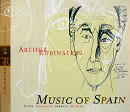 (ie: Mozart's Don Giovanni, Bizet's Carmen, Rossini's Barber of Seville). It was not until 1915 that he finally arrived there as an emergency substitute for another soloist in a Brahms concerto. Local response was ecstatic, far beyond the mere plaudits he had received elsewhere. Rubinstein stayed on to immerse himself in local scenery and culture, returned often and reciprocated audience enthusiasm by becoming both an ardent advocate of Spanish music and one of its most revered exponents. It's rather hard to see exactly how a Pole trained in Germany so succeeded in embodying and communicating the essence of Spain, but the stamp of native approval speaks for itself in validating Rubinstein's credentials to grasp the Spanish heart. This collection comprises a fine overview of his success. Rubinstein was present at the 1916 world premiere in Madrid of Falla's Nights in the Gardens of Spain, and this 1949 recording is the best of his three - despite some dynamic compression, it's wondrously colorful and atmospheric. Also of particular importance is Falla's Ritual Fire Dance, heard in Rubinstein's own piano arrangement with which he had thrilled the composer, although this 1947 recording lacks the impulse and freshness of his first 1930 version (on volume 2). (ie: Mozart's Don Giovanni, Bizet's Carmen, Rossini's Barber of Seville). It was not until 1915 that he finally arrived there as an emergency substitute for another soloist in a Brahms concerto. Local response was ecstatic, far beyond the mere plaudits he had received elsewhere. Rubinstein stayed on to immerse himself in local scenery and culture, returned often and reciprocated audience enthusiasm by becoming both an ardent advocate of Spanish music and one of its most revered exponents. It's rather hard to see exactly how a Pole trained in Germany so succeeded in embodying and communicating the essence of Spain, but the stamp of native approval speaks for itself in validating Rubinstein's credentials to grasp the Spanish heart. This collection comprises a fine overview of his success. Rubinstein was present at the 1916 world premiere in Madrid of Falla's Nights in the Gardens of Spain, and this 1949 recording is the best of his three - despite some dynamic compression, it's wondrously colorful and atmospheric. Also of particular importance is Falla's Ritual Fire Dance, heard in Rubinstein's own piano arrangement with which he had thrilled the composer, although this 1947 recording lacks the impulse and freshness of his first 1930 version (on volume 2).
- Music of France - Ravel: Valses nobles et sentimentales, Forlane, La vallee des cloches; Poulenc: Mouvements perpetuels, 2 Intermezzos; Faure: Nocturne; Chabrier: Scherzo-valse (all 1963); Debussy: La soiree dans Grenade, Jardins sous la pluie, Hommage a Rameau; Reflets dans l'eau, La plus que lente, Poissons d'or (1945). Volume 43.
- Franck: Prelude, Chorale and Fugue; Debussy: La plus que lente, Hommage a Rameau, Poissons d'or, La fille aux cheveux de lin, La cathedrale engloutie, Mistrels, La terrasse des audiences de clair de lune, Ondine, Masques; Schubert: Impromptus, op 90, #s 3 and 4; Grandados: La maja y el ruisenor; Liszt: Liebestraum # 3; Mendelssohn: Spinning Song. (1949-1953). Volume 30.
Rubinstein's Debussy is refreshingly direct, far different from the chiseled perfection of Michelangeli or the misty atmosphere of Geiseking, whom we have come to regard as masters of musical impressionism. 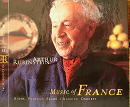 Yet, Rubinstein's approach compares favorably with older practitioners having roots in the authentic style - especially Piero Coppola's pioneering orchestral records (now on Lys CDs) and the few sides cut by Ricardo Vines (on Opal CD 9857), the preeminent French pianist of his generation, to whom Debussy and Ravel entrusted the world premiere of many of their works. And well it should, as Rubinstein was an early advocate of this music, which despite its current popularity took a great deal of proselytizing to catch on outside of its native soil. Unfortunately, no single volume of the Rubinstein Collection does him justice. On the Music of France album (volume 43), the entire 1963 group of Ravel, Poulenc, Faure and Chabrier is wonderfully colorful yet restrained, but the 1945 Debussy set is unfeeling and bland (and crudely recorded). Perhaps recognizing this, Rubinstein recut four of the pieces and added five others far more successfully in 1952 (on volume 30). The Franck opener sets the stage with a reading of nobility and strength. Yet, Rubinstein's approach compares favorably with older practitioners having roots in the authentic style - especially Piero Coppola's pioneering orchestral records (now on Lys CDs) and the few sides cut by Ricardo Vines (on Opal CD 9857), the preeminent French pianist of his generation, to whom Debussy and Ravel entrusted the world premiere of many of their works. And well it should, as Rubinstein was an early advocate of this music, which despite its current popularity took a great deal of proselytizing to catch on outside of its native soil. Unfortunately, no single volume of the Rubinstein Collection does him justice. On the Music of France album (volume 43), the entire 1963 group of Ravel, Poulenc, Faure and Chabrier is wonderfully colorful yet restrained, but the 1945 Debussy set is unfeeling and bland (and crudely recorded). Perhaps recognizing this, Rubinstein recut four of the pieces and added five others far more successfully in 1952 (on volume 30). The Franck opener sets the stage with a reading of nobility and strength.
- Franck: Sonata for Violin and Piano (with Jascha Heifetz, 1937); Faure: Nocturne # 3 (1938); Poulenc: 3 Mouvements perpetuels (1938); Napoli Suite (1947); Albeniz: Cordoba, Sevillanas, Evocacion, Navarra (1929), Triana (1931). Volume 7.
Rubinstein and Heifetz never liked each other; their egos were too strong and their personalities too dissimilar. Throughout their famous trio sessions with Feuermann and then Piatigorsky they reportedly squabbled 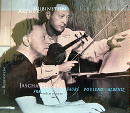 constantly over recording balances and which takes to release. Yet, they achieved a wondrous cohesion in this, their only duo collaboration. Heifetz made the greater adjustment of expressive style, accommodating Rubinstein's rich tone to produce playing of remarkable impulse, passion and feeling. Rubinstein, though, adopted some of Heitetz's focussed objectivity to play with uncommon detail and precision. The result was a reading of gripping intensity and full-bodied ardor, an ideal realization of Franck's score. The French and Spanish short pieces that complete this volume have a similarly fleet, headlong drive in comparison to the more mellow atmospheric remakes on volumes 43 and 30. constantly over recording balances and which takes to release. Yet, they achieved a wondrous cohesion in this, their only duo collaboration. Heifetz made the greater adjustment of expressive style, accommodating Rubinstein's rich tone to produce playing of remarkable impulse, passion and feeling. Rubinstein, though, adopted some of Heitetz's focussed objectivity to play with uncommon detail and precision. The result was a reading of gripping intensity and full-bodied ardor, an ideal realization of Franck's score. The French and Spanish short pieces that complete this volume have a similarly fleet, headlong drive in comparison to the more mellow atmospheric remakes on volumes 43 and 30.
Chamber Music
Rubinstein reveled in chamber music. His most famous series was a 1941 set of trios with violinist Jascha Heifetz and cellist Emmanuel Feuermann (on volumes 12 and 24), but while athletic and propulsive, they project a disembodied sense of three virtuoso superstars preening for attention rather than attempting to integrate themselves into the tupe of unified vision that constitutes the true splendor of chamber music. For that, Rubinstein turned to younger colleagues.
- Mozart: Piano Quartets #s 1 and 2 (with members of the Guarneri Quartet, 1971), Rondo, K. 511 (1959). Volume 75.
Rubinstein admired Mozart for having efficiently pressed his heart and soul into a mold of classicism and aspired toward the goal of a direct and simple style of performance. 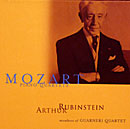 There's none of the daintiness of the rococo approach to Mozart of Gieseking and others of Rubinstein's generation. Yet, there's little of the delicacy, lean textures, fleet tempos and lightness of touch of the classic 1934 account of Schnabel and the Pro Arte Quartet or the slightly more inflected but fundamentally similar 1946 reading by Szell and the Budapest. Rather, Rubinstein plays the Quartets (and the young Guarneri members gladly follow his lead) as pure music, respectful and drained of overt excitement, with emotions largely repressed, a thick sonority, deliberate pacing and few romantic artifacts. Its overall moderation may prove frustrating for those accustomed to structural signposts, stylish embellishments or bold interpretive initiative in their Mozart. If his Piano Quartets evoke Brahms, then Rubinstein's Rondo would fit right into a Chopin recital, reflecting the same evocative but attenuated soulfulness. There's none of the daintiness of the rococo approach to Mozart of Gieseking and others of Rubinstein's generation. Yet, there's little of the delicacy, lean textures, fleet tempos and lightness of touch of the classic 1934 account of Schnabel and the Pro Arte Quartet or the slightly more inflected but fundamentally similar 1946 reading by Szell and the Budapest. Rather, Rubinstein plays the Quartets (and the young Guarneri members gladly follow his lead) as pure music, respectful and drained of overt excitement, with emotions largely repressed, a thick sonority, deliberate pacing and few romantic artifacts. Its overall moderation may prove frustrating for those accustomed to structural signposts, stylish embellishments or bold interpretive initiative in their Mozart. If his Piano Quartets evoke Brahms, then Rubinstein's Rondo would fit right into a Chopin recital, reflecting the same evocative but attenuated soulfulness.
- Beethoven: Violin Sonatas #s 5 (“Spring”) and 9 (“Kreutzer”) (1958) and # 8 (1961). Henryk Szeryng, violin. Volume 40.
Perhaps the most telling performance of these three is the “Kreutzer.” In his famous short story, Leo Tolstoy marvelled at the absurdity of genteel ladies graciously receiving this work 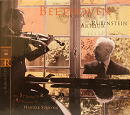 in a staid formal setting, and indeed my favorite performances are those which present the first movement in all its hyper-dramatic brutality, especially the sensational 1940 Library of Congress recital of Joseph Szigeti and Bela Bartok (on Vanguard CD 8008). The 1949 Heifetz/Moisewitch record (on BMG 61738) is nearly as startling for its sheer, unabashed energy. Yet, the problem with such an approach is that the remainder of the work, comprising the traditional forms of variations and a rondo, fall awfully flat in comparison. Draining the first movement of its inherent drama (as with the famous 1936 Kreisler/Rupp records on Biddulph) yields a more integrated experience, but at the unacceptable cost of utterly depriving the work of its opening revolutionary spirit. Perhaps Szeryng and Rubinstein seized upon the best solution - to present the first movement with a constant tension of repressed emotions boiling beneath the classical surface, followed by a deeply-felt set of variations and culminating in a sharp, forceful conclusion. The result is that the finale feels like a genuine fulfillment rather than a mere afterthought. It's also one of those performances that suggest what others state and thus continues to fascinate and never gets tiresome with repeated hearings. The other two sonatas are wonderful as well, the “Spring” bursting with exquisite vernal beauty and # 8 a perfect blend of grace and rhythmic vigor, although its ending is marred by considerable overload distortion. in a staid formal setting, and indeed my favorite performances are those which present the first movement in all its hyper-dramatic brutality, especially the sensational 1940 Library of Congress recital of Joseph Szigeti and Bela Bartok (on Vanguard CD 8008). The 1949 Heifetz/Moisewitch record (on BMG 61738) is nearly as startling for its sheer, unabashed energy. Yet, the problem with such an approach is that the remainder of the work, comprising the traditional forms of variations and a rondo, fall awfully flat in comparison. Draining the first movement of its inherent drama (as with the famous 1936 Kreisler/Rupp records on Biddulph) yields a more integrated experience, but at the unacceptable cost of utterly depriving the work of its opening revolutionary spirit. Perhaps Szeryng and Rubinstein seized upon the best solution - to present the first movement with a constant tension of repressed emotions boiling beneath the classical surface, followed by a deeply-felt set of variations and culminating in a sharp, forceful conclusion. The result is that the finale feels like a genuine fulfillment rather than a mere afterthought. It's also one of those performances that suggest what others state and thus continues to fascinate and never gets tiresome with repeated hearings. The other two sonatas are wonderful as well, the “Spring” bursting with exquisite vernal beauty and # 8 a perfect blend of grace and rhythmic vigor, although its ending is marred by considerable overload distortion.
- Brahms: Violin Sonatas 1, 2 and 3 (with Henryk Szeryng, violin, 1960). Volume 41.
Here, Szeryng's sweet sound and dazzling palette of tonal color provide a magnificent complement for Rubinstein's rich, vibrant glow.  Despite their different ages and backgrounds, they present a highly unified conception of these works, full of ardent yearning and energy. Despite their different ages and backgrounds, they present a highly unified conception of these works, full of ardent yearning and energy.
- Brahms: Piano Trio # 3 (1972); Schubert: Piano Trio # 2 (1974) (with Henryk Szeryng, violin and Pierre Fournier, cello). Volume 73.
The three Brahms (1972) and the two Schubert (1974) trios were Rubinstein's last chamber music recordings. Ironically, the Schubert # 2 was to have been one of his very first, but that 1935 project 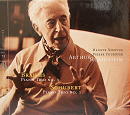 with Heifetz and Feuermann never materialized. Judging from the # 1 which they recorded in 1941, it would have been brilliant and perhaps more suited to Schubert's youthful essence than the expansive, luxuriant texture Rubinstein crafted here in his 88th year. (Heifetz finally recorded # 2 with Piatigorsky and Lateiner in 1963 in an athletic and propulsive performance unreleased until volume 38 of the Heifetz Collection, BMG 61769.) While it perhaps can be questioned whether the Schubert is idiomatic, no such reservation can apply to the Brahms. As aptly described in Harris Goldsmith's fine notes, it's filled with urgency, heart and spontaneity, even while ensuring an uncluttered clarity of conception. Both the Schubert and the Brahms share a spirit, finesse and secure sense of style that belie Rubinstein's advanced age and serve as fine capstones to the career of not only a master pianist but one of the greatest chamber musicians on record. with Heifetz and Feuermann never materialized. Judging from the # 1 which they recorded in 1941, it would have been brilliant and perhaps more suited to Schubert's youthful essence than the expansive, luxuriant texture Rubinstein crafted here in his 88th year. (Heifetz finally recorded # 2 with Piatigorsky and Lateiner in 1963 in an athletic and propulsive performance unreleased until volume 38 of the Heifetz Collection, BMG 61769.) While it perhaps can be questioned whether the Schubert is idiomatic, no such reservation can apply to the Brahms. As aptly described in Harris Goldsmith's fine notes, it's filled with urgency, heart and spontaneity, even while ensuring an uncluttered clarity of conception. Both the Schubert and the Brahms share a spirit, finesse and secure sense of style that belie Rubinstein's advanced age and serve as fine capstones to the career of not only a master pianist but one of the greatest chamber musicians on record.
- Brahms: Piano Trios #s 1 & 2 (1972) (with Henryk Szeryng, violin and Pierre Fournier, cello). Volume 72.
Although both trios are beautifully played, the #1 sounds a bit ponderous and heavy-handed. It's a serious work, to be sure, but a youthful one as well.  It's not just a matter of the deliberate pace - the 1952 Prades version by Isaac Stern, Pablo Casals and Myra Hess (on Sony SMK 58994) is even slower yet enlivened by a grace and lightness that tempers those artists' obvious commitment. Rubinstein's earlier recording with Heifetz and Feuermann (on volume 24) has a more suitable texture (and is five minutes quicker). It's not just a matter of the deliberate pace - the 1952 Prades version by Isaac Stern, Pablo Casals and Myra Hess (on Sony SMK 58994) is even slower yet enlivened by a grace and lightness that tempers those artists' obvious commitment. Rubinstein's earlier recording with Heifetz and Feuermann (on volume 24) has a more suitable texture (and is five minutes quicker).
- Schumann: Piano Quintet, Op. 44 (1966); Dvorak: Piano Quartet # 2, Op. 87 (1970) (with the Guarneri Quartet). Volume 66.
Rubinstein’s records with the Guarneri Quartet were the culmination of his lifelong involvement with chamber music. As he approached his ‘eighties, he may have had to turn to younger colleagues out of necessity, but despite the extreme difference in their ages,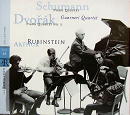 his match with the Guarneri was propitious. Max Wilcox, Rubinstein’s producer, had produced the Guarneri's two debut albums of Mozart, Dvorak and Smetana quartets and urged the pianist to hear them. Rubinstein was enthralled. The Guarneri had been recently minted at Marlboro where their mentors had been Serkin and Casals, who refined any potential sharp or aggressive edge of their young protégés and instead imparted their own outlook of moderation and even-temperament. The Guarneri's first recordings were beautifully blended and surprisingly mellow. Thus, they already were a perfect match for Rubinstein and had no need to sublimate their own character to meet his disposition. The Schumann Quintet was their second collaboration, recorded on an impulse without prior rehearsal the day after their inaugural taping of the Brahms Quintet. I prefer the fiery impulse of the famous 1927 Flonzaley/Gabrilowitsch reading (on Biddulph LAB 072-3), but Rubinstein and the Guarneri achieve a rich and weighty presentation of smooth, flowing continuity. The Dvorak Quartet # 2, while not among the most inspired or inviting of his works, is given a similarly plush and finely polished presentation, with especially glowing cantabile elements. his match with the Guarneri was propitious. Max Wilcox, Rubinstein’s producer, had produced the Guarneri's two debut albums of Mozart, Dvorak and Smetana quartets and urged the pianist to hear them. Rubinstein was enthralled. The Guarneri had been recently minted at Marlboro where their mentors had been Serkin and Casals, who refined any potential sharp or aggressive edge of their young protégés and instead imparted their own outlook of moderation and even-temperament. The Guarneri's first recordings were beautifully blended and surprisingly mellow. Thus, they already were a perfect match for Rubinstein and had no need to sublimate their own character to meet his disposition. The Schumann Quintet was their second collaboration, recorded on an impulse without prior rehearsal the day after their inaugural taping of the Brahms Quintet. I prefer the fiery impulse of the famous 1927 Flonzaley/Gabrilowitsch reading (on Biddulph LAB 072-3), but Rubinstein and the Guarneri achieve a rich and weighty presentation of smooth, flowing continuity. The Dvorak Quartet # 2, while not among the most inspired or inviting of his works, is given a similarly plush and finely polished presentation, with especially glowing cantabile elements.
- Brahms: Piano Quintet, Op. 34 (1966); Dvorak: Piano Quintet, Op. 81 (1971, both with the Guarneri Quartet). Volume 67.
Glenn Gould, not known for his effusive praise of fellow artists, famously proclaimed the Rubinstein/Guarneri Brahms the greatest chamber music performance he had ever heard. 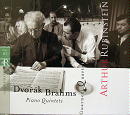 Of course, that may not be quite as strong an endorsement as it first appears - after all, Gould was a man of bizarre musical taste, who denigrated much of Mozart and Beethoven (and all of Chopin and Liszt) and who insisted that Orlando Gibbons was the greatest composer of all time. Even so, this is a radiant performance, effortlessly blending Brahms' youthful impulse with mature probity. The cohesion, both technical and emotional, between piano and strings is astoundingly precise. The opening and closing movements of the Dvorak seem a bit thicker and more emphatic than the music requires, but the Dumka springs to life and the Scherzo furiant startles with its crackling energy. Of course, that may not be quite as strong an endorsement as it first appears - after all, Gould was a man of bizarre musical taste, who denigrated much of Mozart and Beethoven (and all of Chopin and Liszt) and who insisted that Orlando Gibbons was the greatest composer of all time. Even so, this is a radiant performance, effortlessly blending Brahms' youthful impulse with mature probity. The cohesion, both technical and emotional, between piano and strings is astoundingly precise. The opening and closing movements of the Dvorak seem a bit thicker and more emphatic than the music requires, but the Dumka springs to life and the Scherzo furiant startles with its crackling energy.
- Fauré: Piano Quartet # 1, Op. 15; Schumann: Piano Quintet, Op. 44 (with the Paganini Quartet, 1949). Volume 23.
Rubinstein's acclaimed series with the Guarneri Quartet has tended to eclipse his few earlier chamber records. His remakes of these pieces with the Guarneri  had to have been out of love for the works, rather than dissatisfaction with these two sensational readings. The Paganini Quartet combined a sweet, casual "French" sound with invigorating American energy. The Fauré charges ahead with youthful impulse and sends off sparks of excitement, while the Schumann is filled with finely-graded dynamics and subtly-nuanced balances. In each case, the difference with the lush Guarneri remakes (on volumes 74 and 66 respectively) is that of an older Rubinstein content to bask in the luxuries of life, versus a more youthful (although by no means young) artist still eager to savor everything life has to offer. The 1949 recordings (abetted by excellent transfers) are uncommonly detailed for their time. had to have been out of love for the works, rather than dissatisfaction with these two sensational readings. The Paganini Quartet combined a sweet, casual "French" sound with invigorating American energy. The Fauré charges ahead with youthful impulse and sends off sparks of excitement, while the Schumann is filled with finely-graded dynamics and subtly-nuanced balances. In each case, the difference with the lush Guarneri remakes (on volumes 74 and 66 respectively) is that of an older Rubinstein content to bask in the luxuries of life, versus a more youthful (although by no means young) artist still eager to savor everything life has to offer. The 1949 recordings (abetted by excellent transfers) are uncommonly detailed for their time.
Concertos
- Saint-Saens: Piano Concerto # 2; Falla: Nights in the Gardens of Spain (Philadelphia Orchestra, Eugene Ormandy conducting, 1969); Franck: Variations symphoniques (Symphony of the Air, Alfred Wallenstein conducting, 1958). Volume 70.
Rubinstein's grand manner ensured his success in all the major Romantic concertos and his multiple recordings of the Beethoven, Brahms, Chopin, Schumann, Grieg and Rachmaninov are all fine. 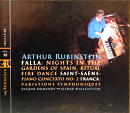 If you're interested, by all means take your pick. But one of his greatest triumphs was in a concerto that never made it into the “heavy rotation” achieved by the others. The Saint-Saens Second perhaps meant more to Rubinstein than the others, as he played it at his first major public concert in December 1900 and his last television appearance in 1979. It's easy to see why it bracketed his career and remained one of his favorites - it's large and splashy, boasting a variety of moods without ever probing too deeply. This recording is a lovely combination of youthful vigor and seasoned reflection, abetted by a warm and empathetic Ormandy/Philadelphia accompaniment. The Franck is conceived along similar lines and provides a nice complement. (The Falla, though, is not as spontaneous, colorful or atmospheric as the 1949 St. Louis/Golschmann version on volume 18 or the 1957 Jorda/San Francisco version on volume 32.) If you're interested, by all means take your pick. But one of his greatest triumphs was in a concerto that never made it into the “heavy rotation” achieved by the others. The Saint-Saens Second perhaps meant more to Rubinstein than the others, as he played it at his first major public concert in December 1900 and his last television appearance in 1979. It's easy to see why it bracketed his career and remained one of his favorites - it's large and splashy, boasting a variety of moods without ever probing too deeply. This recording is a lovely combination of youthful vigor and seasoned reflection, abetted by a warm and empathetic Ormandy/Philadelphia accompaniment. The Franck is conceived along similar lines and provides a nice complement. (The Falla, though, is not as spontaneous, colorful or atmospheric as the 1949 St. Louis/Golschmann version on volume 18 or the 1957 Jorda/San Francisco version on volume 32.)
- Mozart: Piano Concertos #s 17, 20, 21, 23 (RCA Symphony Orchestra, Alfred Wallenstein, 1961) and 24 (RCA Symphony Orchestra, Joseph Krips, 1958). Volume 61, 2 CDs.
Rubinstein claimed to adore Mozart. He saluted Mozart's ability to express in a few bars more than Beethoven could say in an entire movement and how he poured his heart into traditional forms. 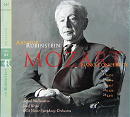 Yet, despite the depth of his proclaimed feelings, Rubinstein played very little Mozart and beyond a single Rondo (K. 511) and the two Piano Quartets on volume 75, recorded only these five concertos. Both the performance and recording of # 24 is dull - dutiful and uninspired, with awkward balances and tentative playing by both soloist and orchestra. Of the others, # 23 was Rubinstein's clear favorite, as he recorded it three times. All the 1961 outings are led by Alfred Wallenstein, who turned to conducting at Toscanini's suggestion after serving as his principal cellist of the New York Philharmonic for seven years. His specialty was as a deeply sympathetic accompanist to such luminaries as Heifetz, Piatigorsky and Rubinstein. Here, he crafts brisk and animated readings within a chamber sonority that complement the solo part without ever competing with or being subsumed by it. The recordings are sharp and clear, marred only by an occasional slight overload in the piano. Yet, despite the depth of his proclaimed feelings, Rubinstein played very little Mozart and beyond a single Rondo (K. 511) and the two Piano Quartets on volume 75, recorded only these five concertos. Both the performance and recording of # 24 is dull - dutiful and uninspired, with awkward balances and tentative playing by both soloist and orchestra. Of the others, # 23 was Rubinstein's clear favorite, as he recorded it three times. All the 1961 outings are led by Alfred Wallenstein, who turned to conducting at Toscanini's suggestion after serving as his principal cellist of the New York Philharmonic for seven years. His specialty was as a deeply sympathetic accompanist to such luminaries as Heifetz, Piatigorsky and Rubinstein. Here, he crafts brisk and animated readings within a chamber sonority that complement the solo part without ever competing with or being subsumed by it. The recordings are sharp and clear, marred only by an occasional slight overload in the piano.
- Liszt: Piano Concerto # 1 (Dallas Symphony Orchestra, Antal Dorati conducting, 1947); Szymanowski: Symphonie Concertante (Los Angeles Philharmonic, Alfred Wallenstein conducting, 1952); Falla: Nights in the Gardens of Spain (San Franscisco Symphony Orchestra, Enrique Jorda conducting, 1957). Volume 32.
As a young man Rubinstein was overwhelmed when he first heard the music of Karol Szymanowski and immediately sought a meeting. The two formed an instant bond - the pianist discovered a gifted composer 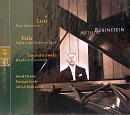 whom he deemed second only to Chopin among Polish compatriots, and Szymanowski, having been enthralled by recitals he had attended, looked to Rubinstein as the champion and foremost interpreter of his work. Unfortunately, despite frequent concert programming, Rubinstein only recorded a few mazurkas and this piece, dedicated to him as a gesture of appreciation for his advocacy. The title of Symphonie Concertante suggests a hybrid form and indeed Szymanowski listed the work as his 4th symphony, although it has the structure and character of a late Romantic concerto and the piano plays a prominent role. Unlike many nationalist composers of his and other eras, Szymanowski dabbled in a number of other styles (Slavic, French, German) before returning to his Polish folk roots and this work melds all these influences with a nice modern cosmopolitan feel and makes a fine impression, even if it’s not an especially memorable or lasting one. The 1952 fidelity is good and Wallenstein, as always, provides wonderfully sympathetic support. Despite rough sound, the 1947 Liszt Concerto is swift, galvanic and exciting, propelled by Dorati with great Hungarian zest. The Falla, too, benefits from being led by a conductor raised in the same cultural tradition as the composer; although it lacks the slightly greater drive, atmosphere and inflection of the earlier Golschmann/St. Louis venture on volume 18, the 1957 early stereo sound is far better and the playing of both soloist and orchestra is more subtle, yielding the finest of Rubinstein’s three recordings of this work. whom he deemed second only to Chopin among Polish compatriots, and Szymanowski, having been enthralled by recitals he had attended, looked to Rubinstein as the champion and foremost interpreter of his work. Unfortunately, despite frequent concert programming, Rubinstein only recorded a few mazurkas and this piece, dedicated to him as a gesture of appreciation for his advocacy. The title of Symphonie Concertante suggests a hybrid form and indeed Szymanowski listed the work as his 4th symphony, although it has the structure and character of a late Romantic concerto and the piano plays a prominent role. Unlike many nationalist composers of his and other eras, Szymanowski dabbled in a number of other styles (Slavic, French, German) before returning to his Polish folk roots and this work melds all these influences with a nice modern cosmopolitan feel and makes a fine impression, even if it’s not an especially memorable or lasting one. The 1952 fidelity is good and Wallenstein, as always, provides wonderfully sympathetic support. Despite rough sound, the 1947 Liszt Concerto is swift, galvanic and exciting, propelled by Dorati with great Hungarian zest. The Falla, too, benefits from being led by a conductor raised in the same cultural tradition as the composer; although it lacks the slightly greater drive, atmosphere and inflection of the earlier Golschmann/St. Louis venture on volume 18, the 1957 early stereo sound is far better and the playing of both soloist and orchestra is more subtle, yielding the finest of Rubinstein’s three recordings of this work.
- Grieg: Piano Concerto (Philadelphia Orchestra, Eugene Ormandy conducting, 1941); Ballade, Album Leaf, 11 Lyric Pieces (1953). Volume 13.
Of all Rubinstein's recordings of the standard concerti, this one (and the Brahms # 2 on volume 1) stands apart. Rubinstein and Ormandy fashion a lean, forceful account of the  Concerto that sounds far more akin to the dry unpretentious Scandinavian texture of the composer's own piano records than the thicker, more overt drama of Rubinstein's three subsequent accounts (or, for that matter, the richer “Philadelphia sound” which Ormandy later developed), and for once the quality of RCA's recording rises above the atrocious sound with which it desecrated its artists throughout the 1940s. The rest of this volume follows suit, with a Ballade characterized by directness and variegated moods, far different than the exquisite poetry and thorough integration of the famous 1928 Godowsky account (on Pearl 9933), and a dozen short pieces assembled to form a suite, not as closely woven as the Ballade, but with considerable logical emotional flow. Concerto that sounds far more akin to the dry unpretentious Scandinavian texture of the composer's own piano records than the thicker, more overt drama of Rubinstein's three subsequent accounts (or, for that matter, the richer “Philadelphia sound” which Ormandy later developed), and for once the quality of RCA's recording rises above the atrocious sound with which it desecrated its artists throughout the 1940s. The rest of this volume follows suit, with a Ballade characterized by directness and variegated moods, far different than the exquisite poetry and thorough integration of the famous 1928 Godowsky account (on Pearl 9933), and a dozen short pieces assembled to form a suite, not as closely woven as the Ballade, but with considerable logical emotional flow.
The Final Records
- 1975 Recital for Israel - Beethoven: Piano Sonata # 23, Op. 57 ("Appassionata"); Schumann: Fantasiestucke, Op. 12; Debussy: Ondine, La plus que lente, Prelude (Pour le Piano); Chopin: Scherzo # 3, 2 Etudes, Nocturne, Op. 25 # 2, Polonaise, Op. 53 ("Heroic"), Waltz, Op. 64, # 2; Mendelssohn: Spinning Song (recorded January 15, 1975 at Ambassador College, Pasadena, California). Volume 80.
The accepted wisdom seems to be that this concert was a disaster. In his fine biography, Harvey Sachs calls the Beethoven “banging, disjointed and sloppy” and out of deference to the artist declines comment on the rest of the program.  In its review of the entire Rubinstein Collection, Gramophone singled it out as “labored and clumsy.” In apologetic liner notes to this CD Harris Goldsmith gingerly offers that it “does not represent [Rubinstein] at his vintage best.” To that I would add that there are scads of wrong notes, stuttering rhythms, unbalanced voices and jagged phrasing. The artistic problems are exacerbated by a substandard recording, with an annoying resonance that blurs the texture, overload distortion that blunts the climaxes and applause that rises too suddenly and sounds fake. Yet, all of this misses the forest for the trees. Rubinstein’s technique clearly had deteriorated, his health was precarious, the color and subtlety of his touch were largely gone and his formerly limitless energy was severely diminished (he foregoes the standard repeat in the Appassionata finale). Still, despite all this, Rubinstein manages to conjure a degree of abandon and risk that harks back to the exhilarating spirit and headlong impulse of his earliest records. Spurred by the stimuli of an intimate setting, an ecstatic audience and a cause in which he fervently believed, Rubinstein summons a lifetime of exalted music-making and perhaps for the final time plays his heart out. You can cringe at all the obvious mistakes if you must (and you'll lose count within seconds) and while the Debussy is rather stilted and the Chopin somewhat faltering, the Beethoven and Schumann are spectacularly alive and far removed from his expressive but measured studio accounts. The final "Heroic" Polonaise, symbolizing as it does the essence of Polish culture and thus Rubinstein's art as well, startles with its heartfelt intensity and sheer raw power. Intrinsic excitement apart, these are not only deeply moving accounts but quite poignant - like an ambitious beginner, Rubinstein’s concept exceeds his grasp, yet unlike an artist embarking upon a lifetime voyage of skills catching up to inspiration, Rubinstein must have known that his powers were slipping increasingly out of his reach. With all due respect to the slights of more knowledgeable critics, this concert strikes me as one of the most astounding ever recorded. While Rubinstein's fingers may have struggled mightily, his heart and soul were all there. In its review of the entire Rubinstein Collection, Gramophone singled it out as “labored and clumsy.” In apologetic liner notes to this CD Harris Goldsmith gingerly offers that it “does not represent [Rubinstein] at his vintage best.” To that I would add that there are scads of wrong notes, stuttering rhythms, unbalanced voices and jagged phrasing. The artistic problems are exacerbated by a substandard recording, with an annoying resonance that blurs the texture, overload distortion that blunts the climaxes and applause that rises too suddenly and sounds fake. Yet, all of this misses the forest for the trees. Rubinstein’s technique clearly had deteriorated, his health was precarious, the color and subtlety of his touch were largely gone and his formerly limitless energy was severely diminished (he foregoes the standard repeat in the Appassionata finale). Still, despite all this, Rubinstein manages to conjure a degree of abandon and risk that harks back to the exhilarating spirit and headlong impulse of his earliest records. Spurred by the stimuli of an intimate setting, an ecstatic audience and a cause in which he fervently believed, Rubinstein summons a lifetime of exalted music-making and perhaps for the final time plays his heart out. You can cringe at all the obvious mistakes if you must (and you'll lose count within seconds) and while the Debussy is rather stilted and the Chopin somewhat faltering, the Beethoven and Schumann are spectacularly alive and far removed from his expressive but measured studio accounts. The final "Heroic" Polonaise, symbolizing as it does the essence of Polish culture and thus Rubinstein's art as well, startles with its heartfelt intensity and sheer raw power. Intrinsic excitement apart, these are not only deeply moving accounts but quite poignant - like an ambitious beginner, Rubinstein’s concept exceeds his grasp, yet unlike an artist embarking upon a lifetime voyage of skills catching up to inspiration, Rubinstein must have known that his powers were slipping increasingly out of his reach. With all due respect to the slights of more knowledgeable critics, this concert strikes me as one of the most astounding ever recorded. While Rubinstein's fingers may have struggled mightily, his heart and soul were all there.
- Beethoven: The Five Piano Concertos (London Philharmonic Orchestra, Daniel Barenboim, 1975); Sonata # 18 (1976). Volumes 77 - 79.
After fine accounts of the Third with Toscanini in 1944 and the Fourth with Beecham in 1947, Rubinstein recorded the full set of Beethoven piano concertos in mono with Joseph Krips 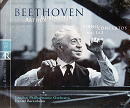 and the Symphony of the Air in 1956 and remade them in stereo with Erich Leinsdorf and the Boston Symphony from 1963-7. Barely a decade later, in his ninetieth year he felt compelled to tape them yet again; obviously, he felt he had something important left to say. Indeed, he did. Barenboim provides deeply sympathetic and exquisitely polished accompaniment, as would be expected. A great pianist in his own right, Barenboim is a protégé of Rubinstein, who launched and nurtured his solo career and then encouraged his interest in becoming a conductor. They remained close personal friends - Barenboim and Jacqueline du Pré even honeymooned at Rubinstein's home. One bizarre feature, though - Rubinstein's trills seem too fast and a bit forced, as if to prove desperately that he still had the stamina and dexterity to pull them off. The sound is afflicted with subsonic rumbling that should have been filtered. The Sonata # 18, from April 1976, was Rubinstein's very last studio recording, rich and autumnal, yet still alive with the wonder and essence of Beethoven. and the Symphony of the Air in 1956 and remade them in stereo with Erich Leinsdorf and the Boston Symphony from 1963-7. Barely a decade later, in his ninetieth year he felt compelled to tape them yet again; obviously, he felt he had something important left to say. Indeed, he did. Barenboim provides deeply sympathetic and exquisitely polished accompaniment, as would be expected. A great pianist in his own right, Barenboim is a protégé of Rubinstein, who launched and nurtured his solo career and then encouraged his interest in becoming a conductor. They remained close personal friends - Barenboim and Jacqueline du Pré even honeymooned at Rubinstein's home. One bizarre feature, though - Rubinstein's trills seem too fast and a bit forced, as if to prove desperately that he still had the stamina and dexterity to pull them off. The sound is afflicted with subsonic rumbling that should have been filtered. The Sonata # 18, from April 1976, was Rubinstein's very last studio recording, rich and autumnal, yet still alive with the wonder and essence of Beethoven.
- Brahms: Piano Concerto # 1 (with the Israel Philharmonic Orchestra conducted by Zubin Mehta, 1976). Volume 81.
Rubinstein told conductor Stanislaw Skrowaczewski before a concert of this work that he wished he could die on stage playing Brahms. In a symbolic sense, he got his wish, as this was his very last recording with orchestra. 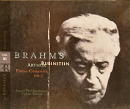 But, fitting for the ever-youthful 89-year old artist, this record represented an important first as well - his only recording with his beloved Israel Philharmonic, which reciprocated his feeling by playing radiantly for him, far above its accustomed norm. Mehta recalls that the sessions, held in Tel Aviv, were difficult, as Rubinstein, nearly blind, could barely see the keyboard and required many retakes; indeed, there's a pervasive feeling here of fragmentation. In 1954 (in a very early stereo taping) Rubinstein had recorded this concerto with Fritz Reiner and the Chicago Symphony (on volume 34) in which ample poetry arose from fleet precision and attentive care to the subtleties of the score. This reading, unfortunately, lacks the cohesive vision of that outing. Details are blurred, with uneven trills, shaky rhythms and little expressive shading. Even so, it's a relaxed and grand performance, although it's shaped largely by Mehta and the orchestra, with Rubinstein reduced largely to the role of a dutiful accompanist, rarely taking the initiative and achieving little interplay. The recording was by Decca, to which RCA consented only when Rubinstein donated his fee to the orchestra; typical of that company's consistent technical excellence, the sound is uncommonly rich, vibrant and detailed. But, fitting for the ever-youthful 89-year old artist, this record represented an important first as well - his only recording with his beloved Israel Philharmonic, which reciprocated his feeling by playing radiantly for him, far above its accustomed norm. Mehta recalls that the sessions, held in Tel Aviv, were difficult, as Rubinstein, nearly blind, could barely see the keyboard and required many retakes; indeed, there's a pervasive feeling here of fragmentation. In 1954 (in a very early stereo taping) Rubinstein had recorded this concerto with Fritz Reiner and the Chicago Symphony (on volume 34) in which ample poetry arose from fleet precision and attentive care to the subtleties of the score. This reading, unfortunately, lacks the cohesive vision of that outing. Details are blurred, with uneven trills, shaky rhythms and little expressive shading. Even so, it's a relaxed and grand performance, although it's shaped largely by Mehta and the orchestra, with Rubinstein reduced largely to the role of a dutiful accompanist, rarely taking the initiative and achieving little interplay. The recording was by Decca, to which RCA consented only when Rubinstein donated his fee to the orchestra; typical of that company's consistent technical excellence, the sound is uncommonly rich, vibrant and detailed.
All told, the final recital and the Beethoven concerti, together with the late chamber music, boast a blend of relaxed confidence and potent undimmed vibrancy that seem utterly incredible for such an aged artist. But then again, perhaps it really was the power of love that kept Rubinstein forever young

Copyright 2001 by Peter Gutmann
|

 Perhaps his own pursuit of romance led Rubinstein to feel a special spiritual kinship with Schumann, the most ardently romantic of all the Romantic composers. Just listen to the opening phrase of the Fantasia - in Rubinstein's hands its yearning tears your heart out, a shattering depiction of the composer's own suffering over his love for Clara, whose father cruelly kept them apart. Yet, Rubinstein constantly tempers the various moods with reflection and melancholy, accurately depicting the composer's delicate and modest personality more accurately than, say, the coy playfulness of Kempff or the bold volatility of Cortot. The mellow vantage Rubinstein brought to his Schumann wasn't merely a function of his advancing age; comparison with the records left by Clara's pupil Fanny Davies (on Pearl CD 9291) reveals a strikingly similar understated approach that must be deemed authentic, as Clara devoted her long teaching career after Robert's death to perpetuating the way he had played his own works and demanding that her students follow suit. The 1958 recording of the Piano Concerto boasts a lovely, lean chamber-textured accompaniment with prominent winds; Rubinstein sounds a bit perfunctory and detached, though, and his rerecording it with Giulini and the Chicago Symphony barely nine years later suggests that he wasn't entirely pleased with the result.
Perhaps his own pursuit of romance led Rubinstein to feel a special spiritual kinship with Schumann, the most ardently romantic of all the Romantic composers. Just listen to the opening phrase of the Fantasia - in Rubinstein's hands its yearning tears your heart out, a shattering depiction of the composer's own suffering over his love for Clara, whose father cruelly kept them apart. Yet, Rubinstein constantly tempers the various moods with reflection and melancholy, accurately depicting the composer's delicate and modest personality more accurately than, say, the coy playfulness of Kempff or the bold volatility of Cortot. The mellow vantage Rubinstein brought to his Schumann wasn't merely a function of his advancing age; comparison with the records left by Clara's pupil Fanny Davies (on Pearl CD 9291) reveals a strikingly similar understated approach that must be deemed authentic, as Clara devoted her long teaching career after Robert's death to perpetuating the way he had played his own works and demanding that her students follow suit. The 1958 recording of the Piano Concerto boasts a lovely, lean chamber-textured accompaniment with prominent winds; Rubinstein sounds a bit perfunctory and detached, though, and his rerecording it with Giulini and the Chicago Symphony barely nine years later suggests that he wasn't entirely pleased with the result.